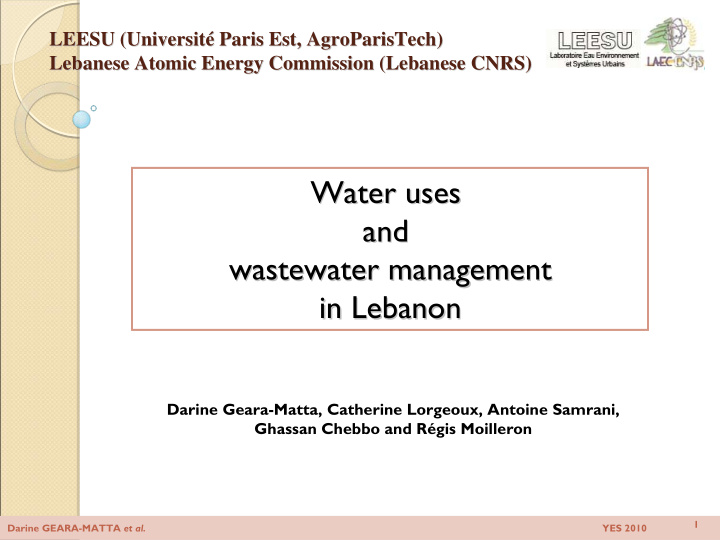



LEESU (Université é Paris Est, Paris Est, AgroParisTech AgroParisTech) ) LEESU (Universit Lebanese Atomic Atomic Energy Energy Commission ( Commission (Lebanese Lebanese CNRS) CNRS) Lebanese Water uses Water uses and and wastewater management wastewater management in Lebanon in Lebanon Darine Geara-Matta, Catherine Lorgeoux, Antoine Samrani, Ghassan Chebbo and Régis Moilleron 1 Darine GEARA-MATTA et al. YES 2010
Plan � Introduction � Water demand � Wastewater management � Conclusion and perspectives 2 Darine GEARA-MATTA et al. YES 2010
Introduction Year Population Comprehensive 1932 793,000 population census 2006 3,900,000 Estimation 2025 4,600,000 60% of the population lives in the narrow coastal strip, i.e. 8% area of Lebanon However Water Population demand Atlas, 2004 3 Darine GEARA-MATTA et al. YES 2010
Introduction National water resources National water resources Water resources of Lebanon derived mainly from rainwater rainwater and snow snow smelting Resources 9,700 Mm 3 8,600 Mm 3 8,600 Mm 3 (1982) (1994) (2001) (data from different studies) 50% evapotranspiration Only 32% available approximately 10% groundwater oozing 8% neighbouring countries available 3,375 Mm 3 2,280 Mm 3 2,600 Mm 3 (1982) (1994) (2001) 4 Darine GEARA-MATTA et al. YES 2010
Water demand 1990 2010 1990 2010 2,290 1,211 Mm 3 /year Mm 3 /year 2020 2030 2020 2030 2,600 3,200 Mm 3 /year Mm 3 /year 5 Darine GEARA-MATTA et al. YES 2010
Water demand From 2000 (tomorrow !), Lebanon is going to face a water crisis since water demand will be higher than water resources By 2030 Water demand will be x1.4 available water resources Change habits on water consumption... Water and Wastewater Management 6 Darine GEARA-MATTA et al. YES 2010
Wastewater management Government plans To date, little information is available in terms of wastewater management Wastewater treatment study is conducted by CDR and MoEW � Determination of sewer networks necessary for the collection of domestic wastewater, in a way that relies as much as possible on gravity transportation � Determination of the characteristics of the coastal WWTPs sea outfalls � Construction of WWTPs and determination of adequate treatment technology 7 Darine GEARA-MATTA et al. YES 2010
Wastewater management Collection networks Less than 60% of the nearly half-a-million buildings in Lebanon are connected to a sewer network Beyrouth (98.3%) Beyrouth suburbs (89.3%) North (53.5%), South (42.1%) Bekaa (41.1%), Mount of Lebanon (33.9%). Unconnected Cesspools and septic tanks directly into rivers and streams and Connected underground Atlas 2004 8 Darine GEARA-MATTA et al. YES 2010
Wastewater management Wastewater disposal Number of sea outfalls (53) has been surveyed but but no information on the state of these outfalls is available (i.e., length, dimensions, loading volume, etc.) => Impact on Mediterranean Sea => Impact on Mediterranean Sea Adapted from CDR/LACECO, 2000 9 Darine GEARA-MATTA et al. YES 2010
Wastewater management Water quality Adapted from CDR/LACECO, 2000 10 Darine GEARA-MATTA et al. YES 2010
Wastewater management WWTP planned project • 12 Coastal WWTPs: Abdeh, Tripoli, Chekka, Batroun, Jbeil, Kesrouan, Dora , Ghadir, Chouf, Saida, Tyre • 20 Inland WWTPs: Zahle, Baalbek and Nabatiyah (Litani River protection) 80 % raw wastewater would be treated (horizon 2020) 11 Darine GEARA-MATTA et al. YES 2010
To date: WWTP Ghadir � 800,000 inhabitants. � � Southern suburbs of Beirut and its surroundings + septic tank septage and leachate from the Naameh landfill (areas not connected ) � Capacity max 2.6 m 3 /s min 1.1 m 3 /s. � Effluents discharged at 2.6 km from coastal area � Preliminary treatment 12 Darine GEARA-MATTA et al. YES 2010
LIFTING To date: WWTP Ghadir Effluent Std SCREENING BOD mg/L 257 25 559 125 COD mg/L No primary treatment nor secundary treatment !!!! DEGRITTING 13 Darine GEARA-MATTA et al. YES 2010
To date : Community-based WWTPs • Functional (2002) • Flow 0.003 m 3 /s • Effluent reuse in agriculture Delays in wastewater works municipalities and communities wastewater collection and treatment (USAID) Some of these community-based projects coincide with the plans of the national program, (Qobayat) Effluent quality does not comply with the national standards for discharge into surface or sea water HASBAYA undesirable!!! Problem faced: Low construction quality Lack of sufficient budgets 14 Darine GEARA-MATTA et al. YES 2010
Conclusion • Water sector Lack of infrastructure • Little information on the wastewater quality in Lebanon is available Academic researches not necessary representative on a national scale • Screening of wastewater of sewage collectors located along the Lebanese coast should be monitored • Establish a database, not yet existing, on the wastewater quality in Lebanon • Assess the efficiency of planned wastewater treatment plants. 15 Darine GEARA-MATTA et al. YES 2010
Perspectives Current situation of planned projects Current situation of planned projects Secondary wastewater treatment plant in Lebanon Under Under No funding Execution Preparation secured 12 17 3 Abdeh WWTP Kesrouan WWTP Networks: fond already available for construction of water and wastewater in Baalbeck and surrounding areas 16 Darine GEARA-MATTA et al. YES 2010
U O Y K R N U A O H N Y T O R I O T N F E T T A 17 Darine GEARA-MATTA et al. YES 2010
Recommend
More recommend